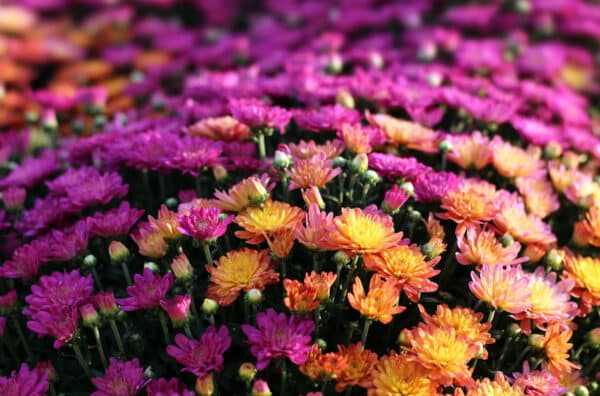Fall Gardening Tips
Summer might be fading into fall, but with these fall gardening tips, your yard doesn’t have to!
There’s still time to get the most out of your summer garden!
Are your summer flowers looking less than cheerful? Give them a nurturing boost for the perfect pick-me-up! Using Plant Food Hero as a foliar spray at 2 oz per gallon every 10-14 days will keep your flowers blooming throughout fall.
Planting Frost-Resistant Flowers in Fall Gives Your Garden a Pop of Color
Gardening in fall can be quite enjoyable and satisfying! Daytime temperatures are more comfortable and pesky insects and weeds have started to die off. While temperatures begin to drop, the soil is still warm enough to encourage rooting. There’s also a greater chance for rain, which helps to keep the ground moist.
You can enjoy your garden oasis a bit longer by choosing varieties that are hardy enough to withstand fall’s cooler temperatures. Some options to consider are Asters, Calendula, Chrysanthemums, Cosmos, Daisies, Marigolds, Pansies, Petunias, and Snapdragons. They offer an array of gorgeous colors and some even repel pests like deer and rodents. If you have any Houseplant Hero, you can spray these flowering plants weekly to get more blooms, bigger flowers, and better color!
Ornamental grasses and veggies like cabbage and kale can add interesting form and texture to your landscape. Be sure to verify USDA hardiness frost guidelines for your area and preferable growing conditions for specific plants. Ideally, you will want to plant 6-8 weeks before the hard-frost date in your zone. (And if you like the taste of kale as well as the look, many varieties of kale actually taste sweeter when picked after the first frost!)
Planting Trees and Shrubs in the Fall
Feeling motivated? Fall is a great time to add new trees and shrubs to your landscape! The combination of warm soil and cool air stimulates root growth to help your tree or shrub get established before the ground freezes. An added bonus? Nurseries often reduce their prices in fall to sell off their inventory as the season comes to a close.
Prepare Your Soil First
Before planting new trees and shrubs, you’ll want to be sure your soil is as healthy as it can be. Dry, hot summers can lead to compacted soil, which in turn can lead to shallow rooting, making trees and shrubs unstable in harsh weather. Trees and shrubs growing in compacted soils are under constant stress, and never achieve their full potential. Obvious signs of this stress are poor growth, fewer flowers, disease, abundance of non-beneficial insects, leaf drop, and dying plants. Like the soil in your lawn, the soil around trees and shrubs needs good aeration and drainage. It also benefits from the addition of organic matter and micronutrients. The easiest way we know of to improve soil structure is by applying our liquid soil conditioner, Aerify PLUS. Start with a heavy application, about 4 oz per 500 sf of root area, and then do monthly applications at 2 oz.
If your soil is already well-aerated, try using Nature’s Magic, our custom blend of liquid seaweed, concentrated humic acid & fulvic acid (liquid carbon), and molasses, to give your soil a boost of life-giving organic materials and fast-track the growth of your new plants.
Choose the Best Tree or Shrub For Your Yard
Again, knowing your hardiness zone will help you narrow down your choices to trees that can survive in your area. Be sure to take stock of the growing conditions of your planting site, especially how much light it gets. Many trees demand all-day sun for best growth, but there are plenty of shrubs that do well in part-sun.
You’ll want to consider the size of the planting area as well. For instance, is the planting spot near a building, fence, or other large plants? If so, measure out how much room there is for a tree to fill without its growth being restricted. You’ll also want to consider where the tree will cast its shadow. You’ll want to avoid creating shade near other planting spots, such as a vegetable garden, where you’ll want full sun.
There are so many varieties to choose from whether you’re planting for privacy, shade, or year-round beauty. Be sure to do some research first, but purchasing from a local nursery can be the best option. They typically stock plants native to your area, and a representative will be able to assist you with planting instructions.
Give Your New Trees and Shrubs a Healthy Advantage
After planting new trees and shrubs in fall, be sure to give them a jumpstart with Nature’s Magic to condition the soil and provide gentle nutrients as the roots settle into their new home. You don’t need to fertilize newly planted trees the first year, but if you have any established trees or shrubs you’d like to fertilize, you may wish to wait until cooler weather to perform a Dormant Feeding.
Provide plenty of water!
Newly planted trees and shrubs, as well as established ones, will tolerate harsh winter conditions better when well watered in fall. Extra water for evergreens is especially important in fall.
Replenish mulch
Add a fresh layer of organic material such as compost, wood chips or shredded leaves and bark around trees and shrubs to protect the roots from winter temperature extremes. Keep mulch from touching the trunks to prevent rot and other diseases. This organic matter will help keep the soil surface soft and permeable, and will encourage earthworms- nature’s best soil aerators.
You’ll reap the benefits of fall gardening throughout the year, but be sure to take the time now to delight in the beauty and wonder of Autumn.



